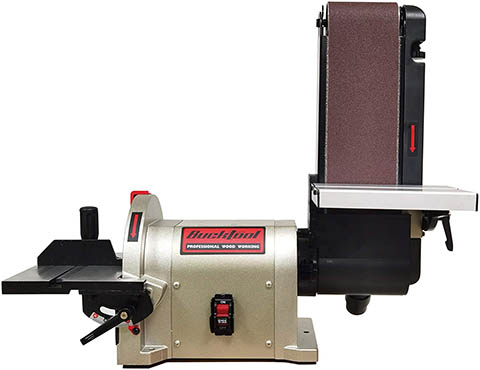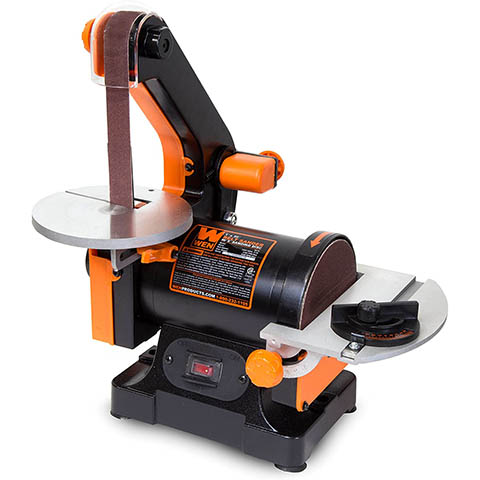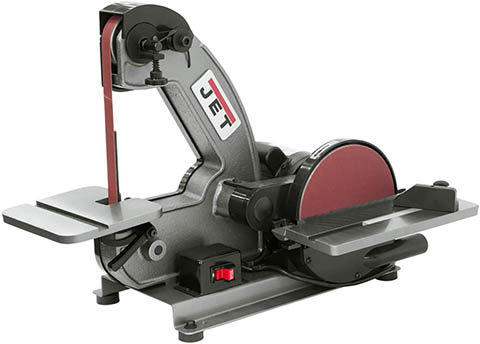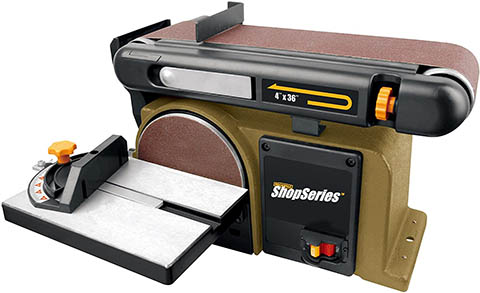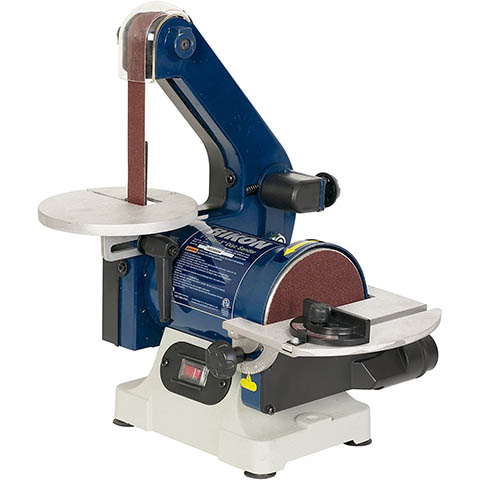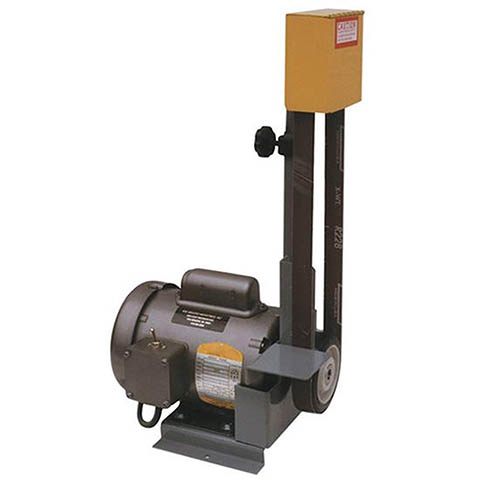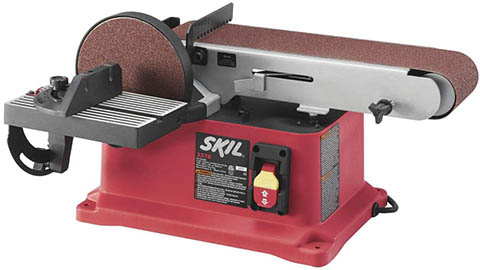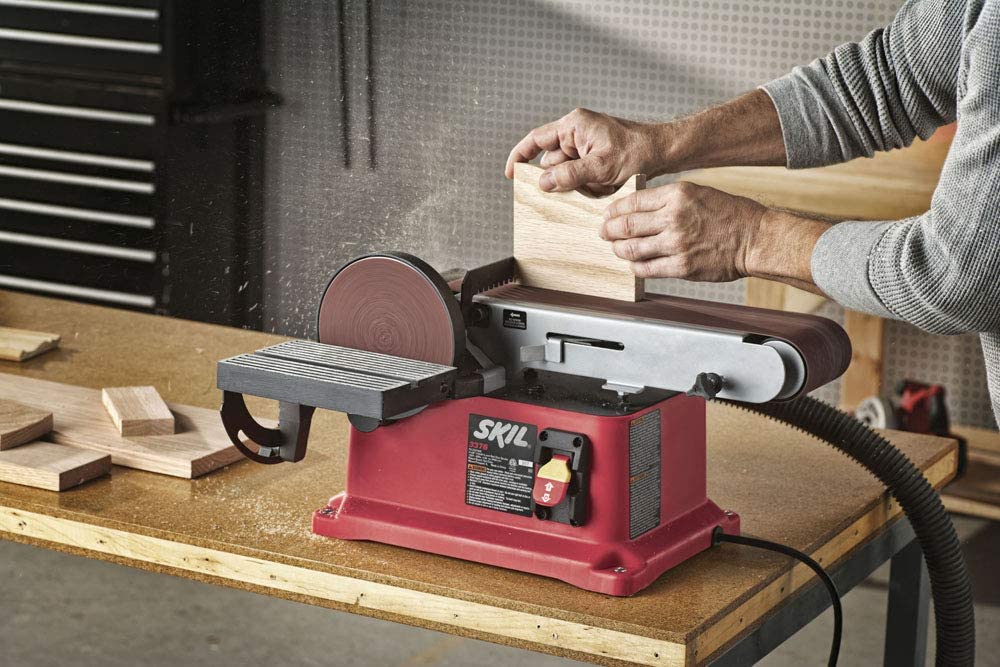10 Best Benchtop Belt Sanders of 2025 – Top Picks & Reviews
-

- Last updated:
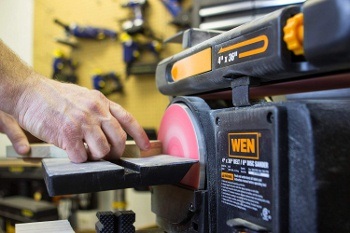

Belt sanders are essential tools in the workshop, and benchtop models add portability to their valuable features. However, they come in all shapes and sizes, and it’s not always easy to know which features you’ll need.
We’ve chosen 10 benchtop belt sander models that outperform the competition. We’ll cover the pros and cons and describe our experience using them. We’ve also included a short buyer’s guide after the reviews, where we’ll look at the components that make up the best benchtop belt sanders so you know what to look for while you shop.
Keep reading while we look at the motor size, RPM, sanding angles, weight, stability, and more to help you make an educated purchase.

A Quick Comparison of Our Favorites in 2025
| Rating | Image | Product | Details | |
|---|---|---|---|---|
Best Overall

|
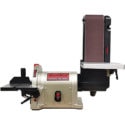
|
BUCKTOOL BD4801 Bench Belt Sander |
|
CHECK PRICE |
Best Value

|
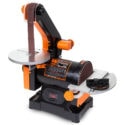
|
WEN 6515T Belt Sander |
|
CHECK PRICE |
Premium Choice

|
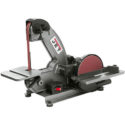
|
Jet Tools J-4002 Bench Belt and Disc Sander |
|
CHECK PRICE |
|
|
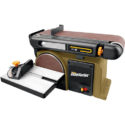
|
Rockwell RK7866 Belt/Disc Combo Sander |
|
CHECK PRICE |
|
|
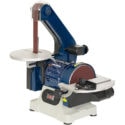
|
RIKON Power Tools 50-151 Belt Disc Sander |
|
CHECK PRICE |
The 10 Best Bench top Belt Sanders
1. BUCKTOOL BD4801 Bench Belt Sander – Best Overall
The BUCKTOOL BD4801 Bench Belt Sander is our pick for the best overall stationary belt sander. The maintenance-free 36-inch belt is easy to change and allows you to sand from 0° to 90°. Also included is an 8-inch disk sander for even more options when you work. A 0.75-horsepower (HP) engine drives the sanders and two dust ports to reduce the sawdust in the air.
The cast aluminum base is lightweight (40 pounds) but durable, and it has four rubber feet to reduce vibrations. A miter gauge on the disk sander helps you create angles, and the disk rotates at 1,725 revolutions per minute (RPM). Since the aluminum base on the BUCKTOOL BD4801 is so lightweight, it can become top-heavy when sanding with the belt sander at 0°. The aluminum also makes it impossible to mount securely to a table.
- Maintenance-free belt
- Direct drive motor
- 75-HP motor, 4 amps
- Cast aluminum base
- Rubber feet
- 36-inch belt
- 8-inch sanding disk
- 1,725 RPM
- Hard to mount
2. WEN 6515T Belt Sander – Best Value
The WEN 6515T Belt Sander is our pick for the best benchtop belt sander for the money. It’s a two-in-one sander that can sand with a belt or a disk and uses a 2.3 amp motor that can reach up to 3,450 RPM with the disc sander and 3,160 feet per minute (FPM) with the belt.
It’s lightweight at only 16 pounds, but the heavy-duty base keeps it pretty stable. Two dust ports help eliminate sawdust, and a belt guard helps reduce the risk of injury. A miter gauge helps you make perfect angles.
The downside to the WEN 6515T is that both the belt and disk decks are flimsy, and you need to be careful not to press too hard. The deck on the belt also loosens constantly from the vibrations.
- Belt and disc sanding
- 3-amp motor
- 3,450 RPM
- 3,160 FPM
- Includes a miter gauge
- Includes sanding disc and belt
- 5-inch disk
- 30-inch belt
- Weighs only 16 lbs
- Belt deck loosens easily
- Flimsy decks
3. Jet Tools J-4002 Bench Belt and Disc Sander – Premium Choice
The Jet Tools J-4002 Bench Belt and Disc Sander is our premium-choice benchtop belt sander. It uses a 0.33-HP motor to reach speeds up to 1,725 RPM and drives the disk sander and belt. The belt is 42 inches long, and the disk is 8 inches. It features a heavy-duty steel base with rubber feet to help reduce vibration.
The tables are iron for better stability and durability, and a deluxe miter gauge turns and locks at the most common angles up to 45°. At 63 pounds, it is stable, doesn’t move while you are working, and features an adjustable dust deflector and dust chute. The Jet Tools J-4002 Is an amazing Sander, but the guards are hard to remove, so changing the belts can be time-consuming.
- Idler wheel cover
- 33-HP engine
- Deluxe miter gauge
- Iron table
- Heavy-duty steel base
- Rubber feet
- 42-inch belt
- Weighs 63 lbs
- Adjustable dust deflector and dust chute
- Hard to change belts
4. Rockwell RK7866 Belt/Disc Combo Sander
The Rockwell RK7866 Belt/Disc Combo Sander uses 0.5-HP to produce 3,450 RPM. You can use it as a belt or disk sander, and it includes a 36-inch belt and a 6-inch disk. The platform is adjustable between 0° and 90°, and the table adjusts to 45° for plenty of versatility with angles and bevels.
Belt changing is easy with a quick-release tension lever, and a safety switch helps protect from accidental startups. It includes a miter gauge, sanding disk, and sanding belt and is manageable at 41 pounds.
The main problem we experienced with the Rockwell RK7866 was that the 0.5-HP engine wasn’t very powerful. Even moderate pressure causes the machine to vibrate; too much can cause it to bog down and stall. It works well but requires a light touch.
- 36-inch belt
- The adjustable platform between 0° and 90°
- The sanding table adjusts to 45°
- Easy belt changes
- Safety switch
- Includes miter gauge
- Includes sanding disk and sanding belt
- 3450 RPM
- Weighs 41 lbs
- 5-HP engine
- 6-inch disk sander
- Vibrates
- Bogs down
5. RIKON Power Tools 50-151 Belt Disc Sander
The RIKON Power Tools 50-151 Belt Disc Sander uses a 2.3-amp motor to drive the sander up to 3,340 RPM. The belt can tilt to 45° for making beveled cuts, and a belt tracking knob provides the perfect belt alignment. It has a 2-inch dust port and an on-off safety switch.
The downside to the RIKON is its all-aluminum construction. We don’t mind that the body is aluminum, but some parts should be more durable; the sanding disk mandrel is one example. The belts are hard to change because you need to remove several screws, and the small safety on-off switch makes it hard to tell where it’s set and hard to use.
- Belt table tilts to 45°
- Belt tracking knob
- Safety on-off switch
- 2-inch dust port
- 3 amps
- 3340 RPM
- All aluminum
- Small on-off switch
- Hard to change belts
6. Porter-Cable PCB420SA Belt Disc Bench Sander
The Porter-Cable PCB420SA Belt Disc Bench Sander uses a 0.75-HP motor to reach up to 3,450 RPM. It’s dual-purpose like most of the others on this list and can disk or belt sand. The sanding belt will tilt to 90°, and the aluminum tables are lightweight but durable. The sanding belt is 36 inches long, and the disk is 8 inches.
It features a dust port and includes a dust collection bag to reduce the mess in your workshop. The cast-iron base keeps the machine in place and is still manageable at 51.1 pounds. What we didn’t like about the Porter-Cable PCB420SA was that it was hard to change belts because you need to remove several parts. The table locks do not clamp down tight enough and allow angled tables to slip while you’re working.
- 75-HP induction motor
- Aluminum tables
- Cast iron base
- Sanding belt tilts to 90°
- Dust port
- Includes dust collection bag
- 8-inch sanding disc
- 3,450 RPM
- 36-inch sanding belt
- Weighs 51.1 lbs
- Hard to change belts
- Tables don’t hold angles
7. Kalamazoo 1SM Belt Sander
The Kalamazoo 1SM Belt Sander uses a 0.33-HP engine to produce up to 1,725 RPM. The 42-inch belt is 1 inch thick and perfect for intricate work. The lower RPM helps keep the noise down, and the 32-pound weight is easy to move around.
The downside to the Kalamazoo is that the motors get in the way, and unless you’re sanding small objects, they tend to bump into the engine. The table is also thin and weak and placed too low for comfort. There is no sander wheel, which we have grown accustomed to seeing in the other models.
- 33-HP engine
- Weighs 32 lbs
- 42-inch belt
- 1,725 RPM
- Table rest is very weak, too low, and close to the motor
- Motors in the way
- No sander wheel
8. SKIL 3376-01 Belt/Disc Sander
The SKIL 3376-01 Belt/Disc Sander is a 2-in-1 sander with a powerful 0.7-HP motor. The engine drives the 10-inch sanding disk at up to 3,500 RPM, and the belt is adjustable from 0° to 90°. The tension spring adjustment helps keep the belt tracking in line, and it’s incredibly lightweight and weighs only a little over 25 pounds.
The base is stable but contains predrilled holes so you can mount it to a table. The downside to the SKIL 3376-01 is that it can be hard to adjust the belt tension and the tilt. The disk sander is also too high and gets in the way while you are sanding.
- Beveling tabletop
- 0.7-HP
- 0°–90° belt sanding
- Tension spring adjustment
- Base with predrilled holes
- 10-inch sanding disk
- 3,500 RPM
- Weighs 25lbs
- Hard to adjust the tilt
- Hard to adjust the belt tension
- Disk sander gets in the way of the belt
9. Shop Fox W1838 Combo Belt Sander
The Shop Fox W1838 Combo Belt Sander uses a 0.33-HP motor to drive a 27-inch belt and a 6-inch disk sander. It’s lightweight and easy to move at only 22 pounds but features a durable cast-iron base and a bright LED work light. A miter gauge attached to the sanding wheel helps you sand perfect angles, and the table also folds to 45° to help you make beveled edges.
A built-in dust port helps reduce the sawdust in your workshop. While reviewing the Shop Fox W1838, we noticed it was harder to adjust the belt’s tracking than on most models and requires tools. There’s no decibel rating on the package, but the unit seemed louder than many others, and it made a rattling sound.
The belt stays at 45°, and there is no way to adjust it like other models. You need to lock the table in place with an Allen wrench, making it difficult to keep square because it turns the table.
- 33-HP motor
- 27-inch belt
- 6-inch disk
- Cast iron base
- Dust port
- Includes belt and disk
- Miter gauge
- Weighs 22 lbs
- LED work light
- Hard to adjust tracking
- Loud
- No angle adjustments for the belt
- Hard to square table
10. POWERTEC BD1502 Belt Disc Sander
The POWERTEC BD1502 Belt Disc Sander is a two-in-one model with a belt and disk sander for maximum versatility. The belt is 30 inches long, and the disk is 6 inches. The 0.33-HP engine will reach speeds up to 3,450 RPM and has two dust ports to eliminate sawdust. The tables are cast aluminum, and it has a cast-iron base.
Despite the iron base, it’s extremely lightweight at only 18.71 pounds and comes with a sanding disk and belt. The POWERTEC BD1502 is another sander with no decibel rating that users reported is quite loud, and we think it was the loudest of all models.
The engine is too weak and suffers from slowdowns and even stalls while working with light pressure. The base isn’t stable enough to keep the machine in place while working and tends to walk. The safety shields can’t be removed and limit the available sanding area of the belt.
- Belt and disk sander
- Cast aluminum tables
- 3,450 RPM
- 30-inch belt
- 5-inch disk
- Weighs 71 lbs
- Low power
- Loud
- Can’t remove the safety shield
- Moves
Buyer’s Guide – Finding the Best BenchtopBelt Sander
Let’s take a look at some of the most important things to consider before purchasing a new benchtop belt sander.
Engine Strength
The engine’s strength should be the first thing you look at when choosing a benchtop belt sander. While you don’t need much power, an underpowered moor can slow down, shake violently, or stall completely. Most companies use horsepower to show how strong the engine is, and we recommend something with at least 0.5-HP for most people.
If you are only sanding tiny objects and using a light touch, you can get away with something smaller, but the belts are also usually smaller, and the parts are not as durable.
Some companies use amps to show how powerful the engine is, and in that case, we recommend something with at least 2.3 amps. When it comes to engine strength, more is better. It will make sanding easier and faster without jittering, slowing down, or stalling.
RPM and FPM
RPM and FPM are the next characteristics to consider when choosing a benchtop belt sander. Companies usually use RPM when referring to the sanding wheel and FPM when discussing the belt sander, but they both refer to how fast the device turns.
Like horsepower and amps, more is usually better but don’t fall for a high RPM machine with low horsepower. It’s easy to increase RPM with pulleys, but the devices will quickly bog down and stall when you use them because they don’t have enough torque. We recommend looking for a machine that provides at least 1,500 RPM.
Versatility
Most models on our list come with a belt sander and a disk sander for added versatility. These two abrasive surfaces can handle most needs, but you should consider a few factors before buying a benchtop sander.
Belt Sander
The length of the belt matters, and a longer belt will allow you to sand a larger object. You will also need to check the belt’s width and compare it to the projects you plan on completing. A wider belt will sand faster and remove material quickly, while a thinner belt will allow for more precise sanding.
Some belt sanders also enable you to change the belt’s angle between 0° and 90°. Adjustable angles can help make sanding easier and allow you to tackle different projects than with a fixed angle. You will also want to investigate how difficult it is to change the belt.
Some brands have easy systems that use tension, while others may require removing multiple components. If you change belts often, a poorly designed belt-changing mechanism will slow down your work speed.
- Length
- Width
- Angle adjustments
- Belt change method
Disk Sander
Many of the models on our list of reviews also include a disk sander. With disk sanders, the disk’s size and how it attaches to the spindle are essential to their operation. A larger disk gives you a larger sanding surface, which can help shorten the sanding time and extend the disk’s life.
How it attaches to the spindle is also important to consider. Many require you to use an adhesive to glue it on, while others might use a hook-and-latch system. A hook-and-latch system is like Velcro and is much easier to use.
Sometimes, you can convert a glue system into a hook and latch. The table is often adjustable for a disk sander allowing you to create perfect bevels, and it often includes a miter gauge for angled sanding.
- Size
- Attachment method
- Adjustable table
- Miter gauge
Dust Port
We highly recommend purchasing a benchtop belt sander with at least one dust port. Dust ports are critical for keeping contaminants out of the air and maintaining a healthier work environment. Most dust ports connect to a vacuum and remove sawdust as you work.
Stability
One of the biggest things contributing to the stability of your benchtop belt sander is the weight. A heavier machine will walk and hop much less than a lightweight machine. Heavier machines also produce fewer vibrations. Some models have predrilled holes that allow you to fasten the base to the table.
If you can’t or are unwilling to fasten the sander to the table, we recommend the heaviest machine you can manage. A wider base and a low-profile design will also help reduce the movement while you work. We tried to point out any models in our reviews prone to vibration and movement issues.
Safety
One more thing to consider when using these tools is safety equipment. Safety glasses with side support and heavy-duty gloves are necessary when sanding your project to remain injury-free. The most important safety measure is to wear a mask.
Sawdust is terrible for your lungs, but metal dust and finishing compounds can be even worse. Ensure you always wear a mask, have plenty of ventilation, and your exhaust ports are connected and working correctly before beginning any project.

In Conclusion
When choosing the best stationary belt sander, we strongly recommend our pick for the best overall. The BUCKTOOL BD4801 Bench Belt Sander has a powerful 0.75-HP engine and enough weight to hold it in place. It’s a two-in-one machine, so you get a belt sander and a disk, and both are easy to change. The WEN 6515T Belt Sander is our pick for the best value, and although the engine isn’t as powerful as our top model, it still offers the user all of the important features at a reduced price.
We hope you have enjoyed reading our reviews and learned something new from our buyer’s guide. If you think it can be helpful, please share this guide to the best benchtop belt sanders on Facebook and Twitter.
More buying guides like this:
- A closer look at the best belt sanders on the market (that are not necessarily benchtop)
- Belt vs orbital sanders: what are the big differences?
Contents
